Food & Beverage Operation Management: Systems, Services & Control
VerifiedAdded on 2023/01/12
|6
|1368
|73
Report
AI Summary
This report provides an analysis of food and beverage operation management, focusing on various food production systems, types of F&B services commonly used in restaurants, and methods for control and volume forecasting in food production. It discusses conventional service, cook chill, centralized service, and continuous flow systems. Different F&B service types like silver service, cafeteria, buffet, self-service, robotic service, and blue plate service are evaluated. The report also covers Hazard Analysis and Critical Control Points (HACCP) principles and volume forecasting techniques, including standard yield, standard recipes, and standard portion sizes, to control costs and maintain consistency in food quality and service. It concludes by highlighting the importance of these elements in effectively managing a restaurant.
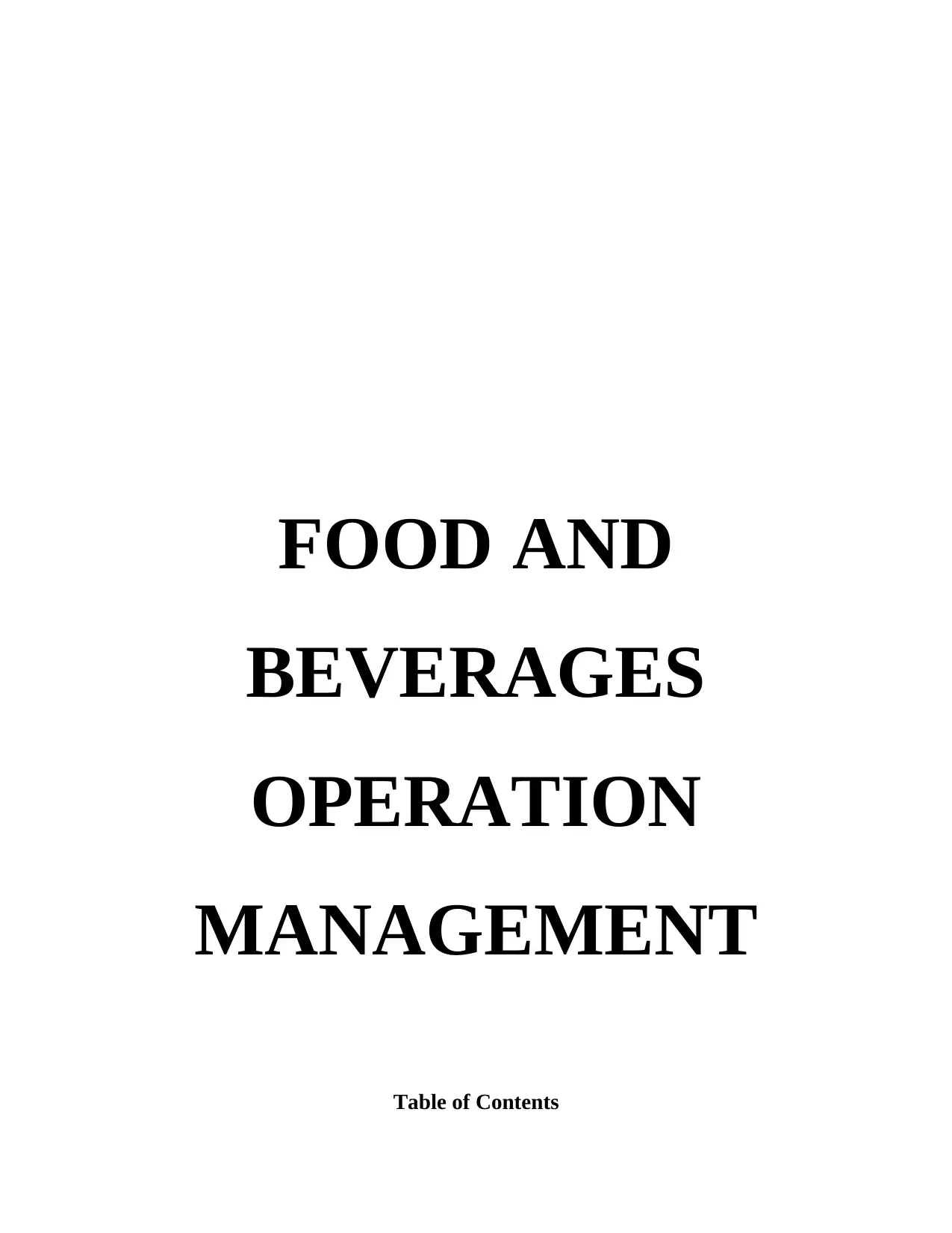
FOOD AND
BEVERAGES
OPERATION
MANAGEMENT
Table of Contents
BEVERAGES
OPERATION
MANAGEMENT
Table of Contents
Paraphrase This Document
Need a fresh take? Get an instant paraphrase of this document with our AI Paraphraser
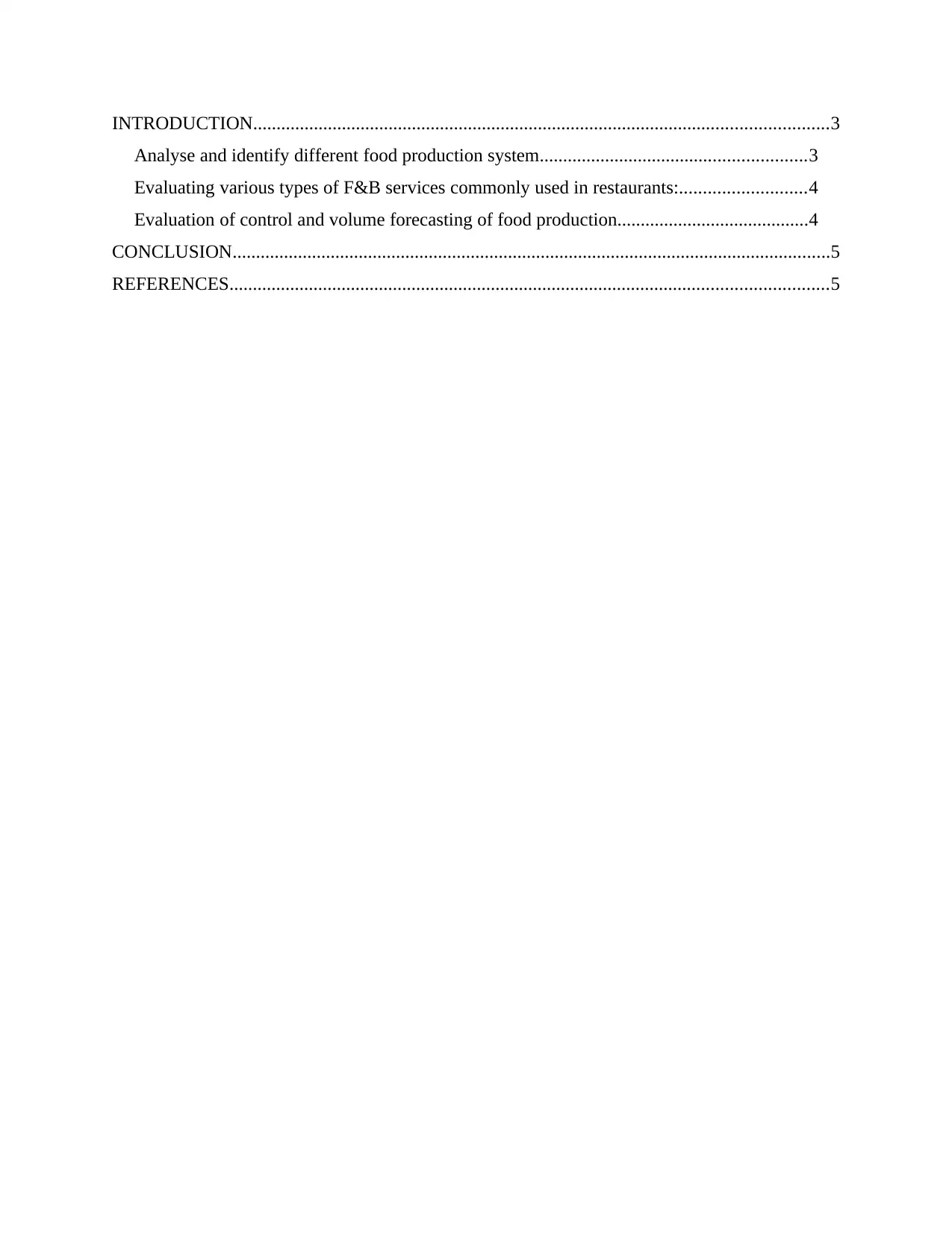
INTRODUCTION...........................................................................................................................3
Analyse and identify different food production system.........................................................3
Evaluating various types of F&B services commonly used in restaurants:...........................4
Evaluation of control and volume forecasting of food production.........................................4
CONCLUSION................................................................................................................................5
REFERENCES................................................................................................................................5
Analyse and identify different food production system.........................................................3
Evaluating various types of F&B services commonly used in restaurants:...........................4
Evaluation of control and volume forecasting of food production.........................................4
CONCLUSION................................................................................................................................5
REFERENCES................................................................................................................................5
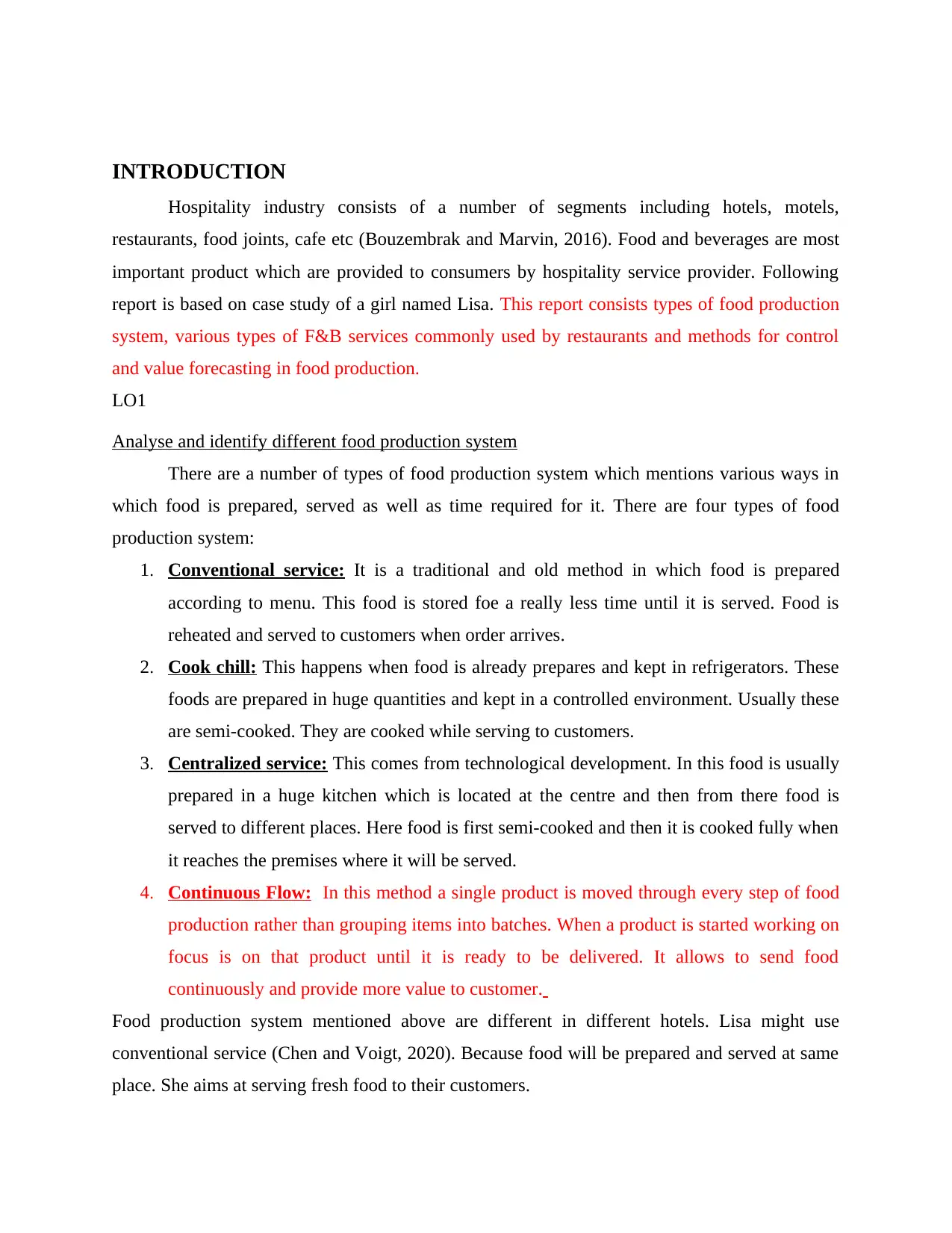
INTRODUCTION
Hospitality industry consists of a number of segments including hotels, motels,
restaurants, food joints, cafe etc (Bouzembrak and Marvin, 2016). Food and beverages are most
important product which are provided to consumers by hospitality service provider. Following
report is based on case study of a girl named Lisa. This report consists types of food production
system, various types of F&B services commonly used by restaurants and methods for control
and value forecasting in food production.
LO1
Analyse and identify different food production system
There are a number of types of food production system which mentions various ways in
which food is prepared, served as well as time required for it. There are four types of food
production system:
1. Conventional service: It is a traditional and old method in which food is prepared
according to menu. This food is stored foe a really less time until it is served. Food is
reheated and served to customers when order arrives.
2. Cook chill: This happens when food is already prepares and kept in refrigerators. These
foods are prepared in huge quantities and kept in a controlled environment. Usually these
are semi-cooked. They are cooked while serving to customers.
3. Centralized service: This comes from technological development. In this food is usually
prepared in a huge kitchen which is located at the centre and then from there food is
served to different places. Here food is first semi-cooked and then it is cooked fully when
it reaches the premises where it will be served.
4. Continuous Flow: In this method a single product is moved through every step of food
production rather than grouping items into batches. When a product is started working on
focus is on that product until it is ready to be delivered. It allows to send food
continuously and provide more value to customer.
Food production system mentioned above are different in different hotels. Lisa might use
conventional service (Chen and Voigt, 2020). Because food will be prepared and served at same
place. She aims at serving fresh food to their customers.
Hospitality industry consists of a number of segments including hotels, motels,
restaurants, food joints, cafe etc (Bouzembrak and Marvin, 2016). Food and beverages are most
important product which are provided to consumers by hospitality service provider. Following
report is based on case study of a girl named Lisa. This report consists types of food production
system, various types of F&B services commonly used by restaurants and methods for control
and value forecasting in food production.
LO1
Analyse and identify different food production system
There are a number of types of food production system which mentions various ways in
which food is prepared, served as well as time required for it. There are four types of food
production system:
1. Conventional service: It is a traditional and old method in which food is prepared
according to menu. This food is stored foe a really less time until it is served. Food is
reheated and served to customers when order arrives.
2. Cook chill: This happens when food is already prepares and kept in refrigerators. These
foods are prepared in huge quantities and kept in a controlled environment. Usually these
are semi-cooked. They are cooked while serving to customers.
3. Centralized service: This comes from technological development. In this food is usually
prepared in a huge kitchen which is located at the centre and then from there food is
served to different places. Here food is first semi-cooked and then it is cooked fully when
it reaches the premises where it will be served.
4. Continuous Flow: In this method a single product is moved through every step of food
production rather than grouping items into batches. When a product is started working on
focus is on that product until it is ready to be delivered. It allows to send food
continuously and provide more value to customer.
Food production system mentioned above are different in different hotels. Lisa might use
conventional service (Chen and Voigt, 2020). Because food will be prepared and served at same
place. She aims at serving fresh food to their customers.
⊘ This is a preview!⊘
Do you want full access?
Subscribe today to unlock all pages.

Trusted by 1+ million students worldwide
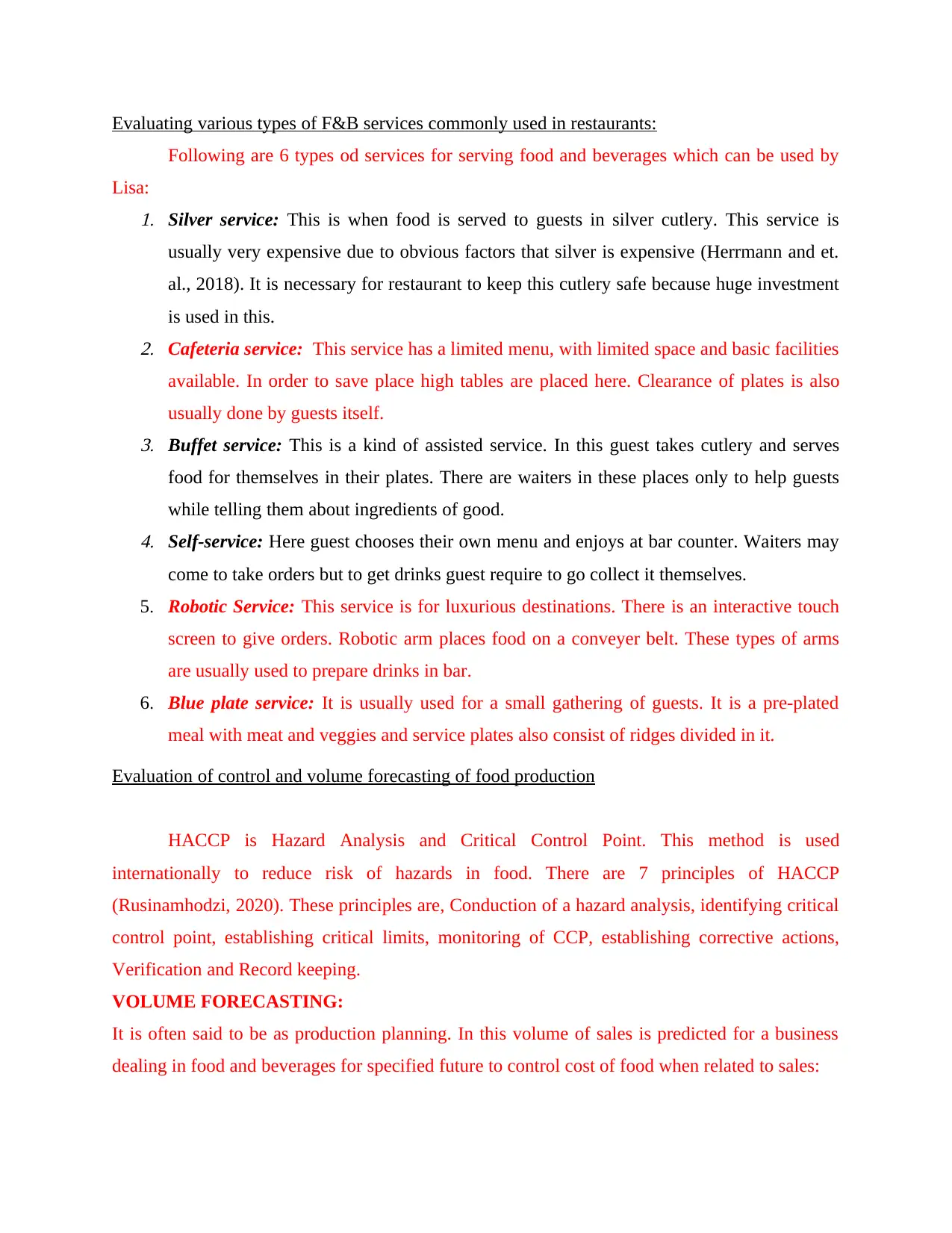
Evaluating various types of F&B services commonly used in restaurants:
Following are 6 types od services for serving food and beverages which can be used by
Lisa:1. Silver service: This is when food is served to guests in silver cutlery. This service is
usually very expensive due to obvious factors that silver is expensive (Herrmann and et.
al., 2018). It is necessary for restaurant to keep this cutlery safe because huge investment
is used in this.2. Cafeteria service: This service has a limited menu, with limited space and basic facilities
available. In order to save place high tables are placed here. Clearance of plates is also
usually done by guests itself.3. Buffet service: This is a kind of assisted service. In this guest takes cutlery and serves
food for themselves in their plates. There are waiters in these places only to help guests
while telling them about ingredients of good.4. Self-service: Here guest chooses their own menu and enjoys at bar counter. Waiters may
come to take orders but to get drinks guest require to go collect it themselves.
5. Robotic Service: This service is for luxurious destinations. There is an interactive touch
screen to give orders. Robotic arm places food on a conveyer belt. These types of arms
are usually used to prepare drinks in bar.
6. Blue plate service: It is usually used for a small gathering of guests. It is a pre-plated
meal with meat and veggies and service plates also consist of ridges divided in it.
Evaluation of control and volume forecasting of food production
HACCP is Hazard Analysis and Critical Control Point. This method is used
internationally to reduce risk of hazards in food. There are 7 principles of HACCP
(Rusinamhodzi, 2020). These principles are, Conduction of a hazard analysis, identifying critical
control point, establishing critical limits, monitoring of CCP, establishing corrective actions,
Verification and Record keeping.
VOLUME FORECASTING:
It is often said to be as production planning. In this volume of sales is predicted for a business
dealing in food and beverages for specified future to control cost of food when related to sales:
Following are 6 types od services for serving food and beverages which can be used by
Lisa:1. Silver service: This is when food is served to guests in silver cutlery. This service is
usually very expensive due to obvious factors that silver is expensive (Herrmann and et.
al., 2018). It is necessary for restaurant to keep this cutlery safe because huge investment
is used in this.2. Cafeteria service: This service has a limited menu, with limited space and basic facilities
available. In order to save place high tables are placed here. Clearance of plates is also
usually done by guests itself.3. Buffet service: This is a kind of assisted service. In this guest takes cutlery and serves
food for themselves in their plates. There are waiters in these places only to help guests
while telling them about ingredients of good.4. Self-service: Here guest chooses their own menu and enjoys at bar counter. Waiters may
come to take orders but to get drinks guest require to go collect it themselves.
5. Robotic Service: This service is for luxurious destinations. There is an interactive touch
screen to give orders. Robotic arm places food on a conveyer belt. These types of arms
are usually used to prepare drinks in bar.
6. Blue plate service: It is usually used for a small gathering of guests. It is a pre-plated
meal with meat and veggies and service plates also consist of ridges divided in it.
Evaluation of control and volume forecasting of food production
HACCP is Hazard Analysis and Critical Control Point. This method is used
internationally to reduce risk of hazards in food. There are 7 principles of HACCP
(Rusinamhodzi, 2020). These principles are, Conduction of a hazard analysis, identifying critical
control point, establishing critical limits, monitoring of CCP, establishing corrective actions,
Verification and Record keeping.
VOLUME FORECASTING:
It is often said to be as production planning. In this volume of sales is predicted for a business
dealing in food and beverages for specified future to control cost of food when related to sales:
Paraphrase This Document
Need a fresh take? Get an instant paraphrase of this document with our AI Paraphraser
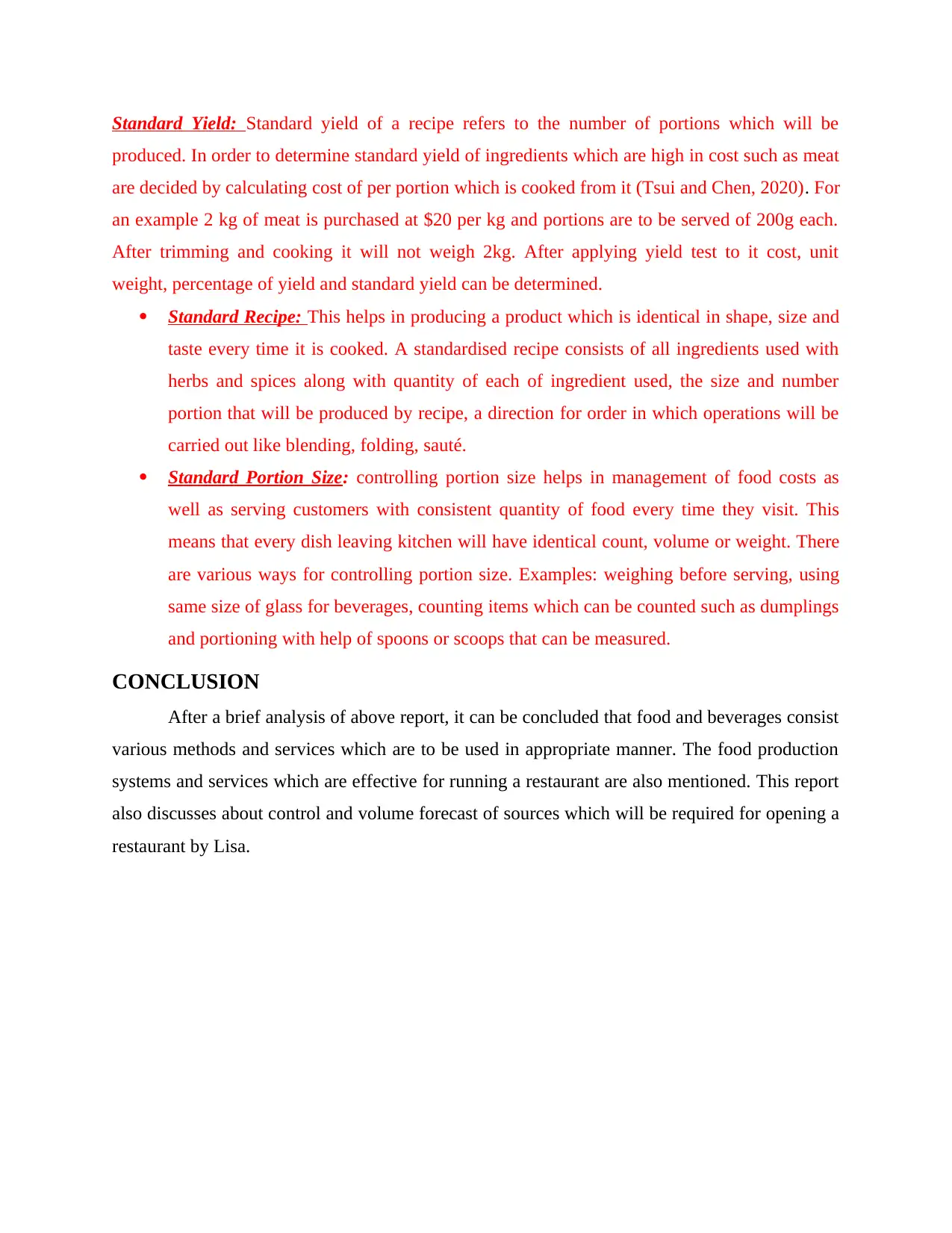
Standard Yield: Standard yield of a recipe refers to the number of portions which will be
produced. In order to determine standard yield of ingredients which are high in cost such as meat
are decided by calculating cost of per portion which is cooked from it (Tsui and Chen, 2020). For
an example 2 kg of meat is purchased at $20 per kg and portions are to be served of 200g each.
After trimming and cooking it will not weigh 2kg. After applying yield test to it cost, unit
weight, percentage of yield and standard yield can be determined.
Standard Recipe: This helps in producing a product which is identical in shape, size and
taste every time it is cooked. A standardised recipe consists of all ingredients used with
herbs and spices along with quantity of each of ingredient used, the size and number
portion that will be produced by recipe, a direction for order in which operations will be
carried out like blending, folding, sauté.
Standard Portion Size: controlling portion size helps in management of food costs as
well as serving customers with consistent quantity of food every time they visit. This
means that every dish leaving kitchen will have identical count, volume or weight. There
are various ways for controlling portion size. Examples: weighing before serving, using
same size of glass for beverages, counting items which can be counted such as dumplings
and portioning with help of spoons or scoops that can be measured.
CONCLUSION
After a brief analysis of above report, it can be concluded that food and beverages consist
various methods and services which are to be used in appropriate manner. The food production
systems and services which are effective for running a restaurant are also mentioned. This report
also discusses about control and volume forecast of sources which will be required for opening a
restaurant by Lisa.
produced. In order to determine standard yield of ingredients which are high in cost such as meat
are decided by calculating cost of per portion which is cooked from it (Tsui and Chen, 2020). For
an example 2 kg of meat is purchased at $20 per kg and portions are to be served of 200g each.
After trimming and cooking it will not weigh 2kg. After applying yield test to it cost, unit
weight, percentage of yield and standard yield can be determined.
Standard Recipe: This helps in producing a product which is identical in shape, size and
taste every time it is cooked. A standardised recipe consists of all ingredients used with
herbs and spices along with quantity of each of ingredient used, the size and number
portion that will be produced by recipe, a direction for order in which operations will be
carried out like blending, folding, sauté.
Standard Portion Size: controlling portion size helps in management of food costs as
well as serving customers with consistent quantity of food every time they visit. This
means that every dish leaving kitchen will have identical count, volume or weight. There
are various ways for controlling portion size. Examples: weighing before serving, using
same size of glass for beverages, counting items which can be counted such as dumplings
and portioning with help of spoons or scoops that can be measured.
CONCLUSION
After a brief analysis of above report, it can be concluded that food and beverages consist
various methods and services which are to be used in appropriate manner. The food production
systems and services which are effective for running a restaurant are also mentioned. This report
also discusses about control and volume forecast of sources which will be required for opening a
restaurant by Lisa.
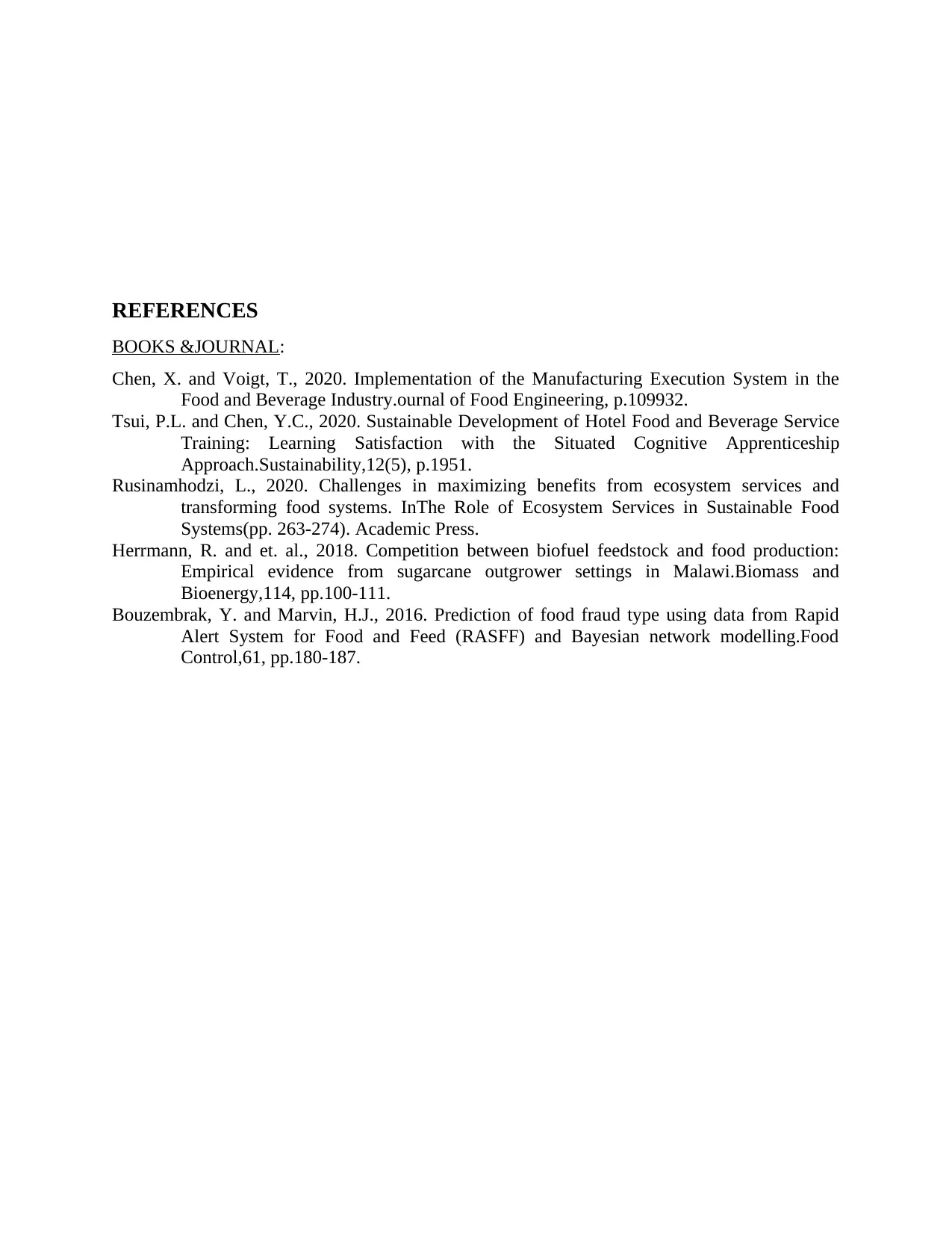
REFERENCES
BOOKS &JOURNAL:
Chen, X. and Voigt, T., 2020. Implementation of the Manufacturing Execution System in the
Food and Beverage Industry.ournal of Food Engineering, p.109932.
Tsui, P.L. and Chen, Y.C., 2020. Sustainable Development of Hotel Food and Beverage Service
Training: Learning Satisfaction with the Situated Cognitive Apprenticeship
Approach.Sustainability,12(5), p.1951.
Rusinamhodzi, L., 2020. Challenges in maximizing benefits from ecosystem services and
transforming food systems. InThe Role of Ecosystem Services in Sustainable Food
Systems(pp. 263-274). Academic Press.
Herrmann, R. and et. al., 2018. Competition between biofuel feedstock and food production:
Empirical evidence from sugarcane outgrower settings in Malawi.Biomass and
Bioenergy,114, pp.100-111.
Bouzembrak, Y. and Marvin, H.J., 2016. Prediction of food fraud type using data from Rapid
Alert System for Food and Feed (RASFF) and Bayesian network modelling.Food
Control,61, pp.180-187.
BOOKS &JOURNAL:
Chen, X. and Voigt, T., 2020. Implementation of the Manufacturing Execution System in the
Food and Beverage Industry.ournal of Food Engineering, p.109932.
Tsui, P.L. and Chen, Y.C., 2020. Sustainable Development of Hotel Food and Beverage Service
Training: Learning Satisfaction with the Situated Cognitive Apprenticeship
Approach.Sustainability,12(5), p.1951.
Rusinamhodzi, L., 2020. Challenges in maximizing benefits from ecosystem services and
transforming food systems. InThe Role of Ecosystem Services in Sustainable Food
Systems(pp. 263-274). Academic Press.
Herrmann, R. and et. al., 2018. Competition between biofuel feedstock and food production:
Empirical evidence from sugarcane outgrower settings in Malawi.Biomass and
Bioenergy,114, pp.100-111.
Bouzembrak, Y. and Marvin, H.J., 2016. Prediction of food fraud type using data from Rapid
Alert System for Food and Feed (RASFF) and Bayesian network modelling.Food
Control,61, pp.180-187.
⊘ This is a preview!⊘
Do you want full access?
Subscribe today to unlock all pages.

Trusted by 1+ million students worldwide
1 out of 6
Related Documents
Your All-in-One AI-Powered Toolkit for Academic Success.
+13062052269
info@desklib.com
Available 24*7 on WhatsApp / Email
![[object Object]](/_next/static/media/star-bottom.7253800d.svg)
Unlock your academic potential
Copyright © 2020–2025 A2Z Services. All Rights Reserved. Developed and managed by ZUCOL.





